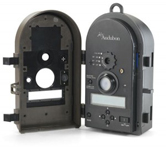|
NEWS FROM ACADEMIC TECHNOLOGY SERVICES
- Slow it down and speed it up:
Inexpensive high speed and time-lapse photography options
- Watch video examples of high speed photography. View web cams demonstrating time-lapse photography.Using words to explain an instantaneous chemical reaction is challenging. That same reaction shown visually can be a much more effective teaching tool. The ability to slow down or speed up time could be key to teaching concepts that are understandable and memorable.
►Read full article...
- Videoconferencing as an educational tool
- As an educator and an expert in your field, you need to consult on your research, provide your students with unique and enriching experiences, collaborate with other institutions’ classes, and promote your department and the University. What if there was an easy way to disseminate your information that included a local, national, and international reach? Videoconferencing is the answer!
►Read full article...
- Next generation clicker is now available for fall
- Over 4,000 students will use i>clickers in UD classes this fall. The new clicker's features and simplicity are a compelling combination for faculty to adopt a technology that’s proven to advance learning. Now is the time for faculty to pick up their new clicker kit and exchange ideas with other faculty during an orientation session.
►Read full article...
Recommended Reading:
On Syllabi and Course Design
Useful ideas for putting the finishing touches on your fall course.
- Google Docs and Google Sites: Convenient and collaborative
- [Note: You don't need to use Google Mail to take advantage of Google Sites and Google Docs.]
On the surface, Google Docs and Google Sites don’t sound much different from other everyday software: Word processing, spreadsheets, presentations, and Web pages. But, having software that runs through a Web browser introduces two game-changing differences: Convenience and collaboration.
►Read full article...
- Instructional projects and Drupal capabilities
- Academic Technology Services (ATS) offers expansive new possibilities for Web development using Drupal. Current development projects include a tool for creating video annotations, lab data collection, instructional simulations, and integration with Google Calendar. These projects are representative of the Web site capabilities afforded by Drupal: a high-level of interaction, handling individual site submissions through a Web browser, delivering instructional session results to a faculty member, and connection to Web-based information sources.
►Read full article...
- iPhone Developer University Program
- You can introduce development of the iOS operating system into your curriculum for free. If you want your students to learn how to develop apps for the iPhone, iPad, or other Apple Web-enabled device, now is your chance. The University of Delaware is a participating member of the iPhone Developer University Program. The program is open to University faculty and staff.
►Read full article...
- Slow it down and speed it up:
Inexpensive high speed and time-lapse photography options
-
-
Using words to explain an instantaneous chemical reaction is challenging. That same reaction shown visually can be a much more effective teaching tool. The ability to slow down or speed up time could be key to teaching concepts that are understandable and memorable.
 High speed video has historically been the realm of professionals because it required thousands of dollars of camera equipment, stands, and lighting. As cameras shrink in size and price, powerful new features are becoming available to non-professionals. The Casio Exilim EX-FC100 (retail about $200) offers a high-speed movie setting that will record videos from 210 to 1,000 frames per second (FPS). Be warned, however, the higher the FPS, the lower the resolution. A video filmed at 210 FPS yields a movie with a resolution that is good for most uses. The resolution for a 1,000 FPS video is really quite low and not very useful. High speed video has historically been the realm of professionals because it required thousands of dollars of camera equipment, stands, and lighting. As cameras shrink in size and price, powerful new features are becoming available to non-professionals. The Casio Exilim EX-FC100 (retail about $200) offers a high-speed movie setting that will record videos from 210 to 1,000 frames per second (FPS). Be warned, however, the higher the FPS, the lower the resolution. A video filmed at 210 FPS yields a movie with a resolution that is good for most uses. The resolution for a 1,000 FPS video is really quite low and not very useful.
In addition, the camera records movies at 720p high-definition resolution (30 FPS), so it is useful to record just about anything. The Casio uses the standard SD memory card, but I've found the battery to be a bit anemic. With that in mind, it's still amazing what capabilities you get in a camera in the sub-$200 range.
 Time-lapse photography is the opposite of high-speed photography. Any camera with an attached intervalometer can be set to take pictures at specified time intervals. Time-lapse photography is the opposite of high-speed photography. Any camera with an attached intervalometer can be set to take pictures at specified time intervals.
But there are some important considerations to think about. Does it need to be weatherproof? Does it need batteries? How can I keep the camera steady?
Most of these questions are resolved with the Wingscapes PlantCam(retail about $70). The original purpose of the PlantCam was -- you guessed it -- to record plants as they grow. But it can be used for much more. The camera itself is encased in rugged weatherproof plastic, so you can safely leave it outdoors. The camera features selectable interval settings from 30 seconds to 1 per day. It can be set to start at a certain time or stop when it gets dark outside. It also records images to a standard SD memory card. 2GB cards can be purchased for under $10 each, which is enough for over 1,500 images at the highest resolution. The kit includes three mounting options: a clamp with an articulating head, nylon straps, or bungee cords to secure the camera to poles or trees. The uses for this camera are endless: record your students assembling a great project for a fast-paced construction movie, capture the progress of a building under construction, or record the tides over the course of a day.
Contact ATS with your ideas or suggestions about high-speed or time-lapse photography.
- Google Docs and Google Sites:
Convenient and collaborative
-
-
On the surface, Google Docs and Google Sites don’t sound much different from other everyday software: Word processing, spreadsheets, presentations, and Web pages. But, having software that runs through a Web browser introduces two game-changing differences: Convenience and collaboration.
Google Docs
The first difference, convenience, means your files will be available to you from any device that runs a Web browser. No matter what Web-enabled device you use – or where -- you'll always have access to files created in Google Docs. You won’t need to transfer files back and forth between devices, use a memory stick, or email documents to yourself. And, you can print documents, convert them into PDF versions, or export them to use with Microsoft Office.
The second difference allows you to collaborate with colleagues and students. Need to co-present a session? Start off in Google Presentations and share the slide show with your co-presenter. Each person can add new slides, edit any slide, and practice the presentation. And, you and your students can use Google Docs for file sharing, group exercises in class, and other collaborative activities.
Want to co-author a conference proposal or other document? Google word processing is your ally. Similarly, spreadsheets can be shared, and they have an extra powerful component: You can easily create Web forms and invite people to enter data directly into your spreadsheet.
In all these examples, you specify who your collaborators are and whether they can edit your document or only view it. For real-time collaboration, try using Skype to talk with others at a distance while working on the same document.
Remember, any document you create can be shared with anyone else – including all udel.edu email addresses, whether or not they use Google Mail as well as individuals outside UD.
Google Docs: Log in to http://gdocs.udel.edu using your UDelNet ID and password.
Google Sites
Google Sites brings convenience and collaboration to the creation of Web sites. It's convenient because you don't need to install additional software or transfer files. Within minutes, you can open a Web page template and easily navigate among the choices to create a basic Web page.
You can then create Web sites by linking pages together with a navigation menu. Google Sites can be shared for collaborative development. You and your students can publish information using Google’s easy Web development tools. And, you can include Google Docs in your Google Web site.
Google Sites: Log in to http://gsites.udel.edu using your UDelNet ID and password.
NOTE
You don't need to use Google Mail to take full advantage of Google Sites and Google Docs. All members of the University community have access to the full range of Google Apps for Education, no matter where they read their email.
Faculty can begin using these two powerful tools today. ATS staff members are available to meet faculty on an individual basis to discuss the use of Google Sites and Google Docs. To get started, visit https://googleapps.udel.edu/.
|
|

 High speed video has historically been the realm of professionals because it required thousands of dollars of camera equipment, stands, and lighting. As cameras shrink in size and price, powerful new features are becoming available to non-professionals. The
High speed video has historically been the realm of professionals because it required thousands of dollars of camera equipment, stands, and lighting. As cameras shrink in size and price, powerful new features are becoming available to non-professionals. The  Time-lapse photography is the opposite of high-speed photography. Any camera with an attached intervalometer can be set to take pictures at specified time intervals.
Time-lapse photography is the opposite of high-speed photography. Any camera with an attached intervalometer can be set to take pictures at specified time intervals.